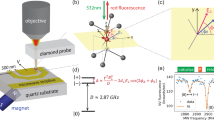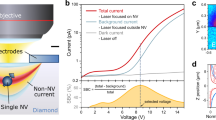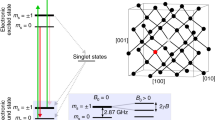Abstract
The nitrogen–vacancy (NV) centre in diamond can be used as a solid-state quantum sensor with applications in magnetometry, electrometry, thermometry and chemical sensing. However, to deliver practical applications, existing NV-based sensing techniques, which are based on bulky and discrete instruments for spin control and detection, must be replaced by more compact designs. Here we show that NV-based quantum sensing can be integrated with complementary metal–oxide–semiconductor (CMOS) technology to create a compact and scalable platform. Using standard CMOS technology, we integrate the essential components for NV control and measurement—microwave generator, optical filter and photodetector—in a 200 μm × 200 μm footprint. With this platform we demonstrate quantum magnetometry with a sensitivity of 32.1 μT Hz−1/2 and simultaneous thermometry.
This is a preview of subscription content, access via your institution
Access options
Access Nature and 54 other Nature Portfolio journals
Get Nature+, our best-value online-access subscription
$29.99 / 30 days
cancel any time
Subscribe to this journal
Receive 12 digital issues and online access to articles
$119.00 per year
only $9.92 per issue
Buy this article
- Purchase on Springer Link
- Instant access to full article PDF
Prices may be subject to local taxes which are calculated during checkout





Similar content being viewed by others
Data availability
The data that support the plots within this paper and other findings of this study are available from the corresponding author upon reasonable request.
References
Kucsko, G. et al. Nanometre-scale thermometry in a living cell. Nature 500, 54–58 (2013).
Neumann, P. et al. High-precision nanoscale temperature sensing using single defects in diamond. Nano Lett. 13, 2738–2742 (2013).
Plakhotnik, T., Doherty, M. W., Cole, J. H., Chapman, R. & Manson, N. B. All-optical thermometry and thermal properties of the optically detected spin resonances of the NV− center in nanodiamond. Nano Lett. 14, 4989–4996 (2014).
Laraoui, A. et al. Imaging thermal conductivity with nanoscale resolution using a scanning spin probe. Nat. Commun. 6, 8954 (2015).
Ovartchaiyapong, P., Lee, K. W., Myers, B. A. & Jayich, A. C. B. Dynamic strain-mediated coupling of a single diamond spin to a mechanical resonator. Nat. Commun. 5, 4429 (2014).
Teissier, J., Barfuss, A., Appel, P., Neu, E. & Maletinsky, P. Strain coupling of a nitrogen-vacancy center spin to a diamond mechanical oscillator. Phys. Rev. Lett. 113, 020503 (2014).
Trusheim, M. E. & Englund, D. Wide-field strain imaging with preferentially aligned nitrogen-vacancy centers in polycrystalline diamond. New J. Phys. 18, 123023 (2016).
Dolde, F. et al. Electric-field sensing using single diamond spins. Nat. Phys. 7, 459–463 (2011).
Chen, E. H. et al. High-sensitivity spin-based electrometry with an ensemble of nitrogen-vacancy centers in diamond. Phys. Rev. A 95, 053417 (2017).
Broadway, D. A. et al. Spatial mapping of band bending in semiconductor devices using in situ quantum sensors. Nat. Electron. 1, 502–507 (2018).
Maze, J. et al. Nanoscale magnetic sensing with an individual electronic spin in diamond. Nature 455, 644–647 (2008).
Balasubramanian, G. et al. Nanoscale imaging magnetometry with diamond spins under ambient conditions. Nature 455, 648–651 (2008).
Grinolds, M. et al. Subnanometre resolution in three-dimensional magnetic resonance imaging of individual dark spins. Nat. Nanotechnol. 9, 279–284 (2014).
Jensen, K. et al. Cavity-enhanced room-temperature magnetometry using absorption by nitrogen-vacancy centers in diamond. Phys. Rev. Lett. 112, 160802 (2014).
Wolf, T. et al. Subpicotesla diamond magnetometry. Phys. Rev. X 5, 041001 (2015).
Glenn, D. R. et al. Single-cell magnetic imaging using a quantum diamond microscope. Nat. Methods 12, 736–738 (2015).
Boss, J. M., Cujia, K., Zopes, J. & Degen, C. L. Quantum sensing with arbitrary frequency resolution. Science 356, 837–840 (2017).
Mamin, H. et al. Nanoscale nuclear magnetic resonance with a nitrogen-vacancy spin sensor. Science 339, 557–560 (2013).
Staudacher, T. et al. Nuclear magnetic resonance spectroscopy on a (5-nanometer)3 sample volume. Science 339, 561–563 (2013).
Häberle, T., Schmid-Lorch, D., Reinhard, F. & Wrachtrup, J. Nanoscale nuclear magnetic imaging with chemical contrast. Nat. Nanotechnol. 10, 125–128 (2015).
Rugar, D. et al. Proton magnetic resonance imaging using a nitrogen–vacancy spin sensor. Nat. Nanotechnol. 10, 120–124 (2015).
Aslam, N. et al. Nanoscale nuclear magnetic resonance with chemical resolution. Science 357, 67–71 (2017).
Lovchinsky, I. et al. Nuclear magnetic resonance detection and spectroscopy of single proteins using quantum logic. Science 351, 836–841 (2016).
Lovchinsky, I. et al. Magnetic resonance spectroscopy of an atomically thin material using a single-spin qubit. Science 355, 503–507 (2017).
Glenn, D. R. et al. High-resolution magnetic resonance spectroscopy using a solid-state spin sensor. Nature 555, 351–354 (2018).
Balasubramanian, G. et al. Ultralong spin coherence time in isotopically engineered diamond. Nat. Mater. 8, 383–387 (2009).
Clevenson, H. et al. Broadband magnetometry and temperature sensing with a light-trapping diamond waveguide. Nat. Phys. 11, 393–397 (2015).
Taylor, J. et al. High-sensitivity diamond magnetometer with nanoscale resolution. Nat. Phys. 4, 810–816 (2008).
Ibrahim, M. I., Foy, C., Kim, D., Englund, D. R. & Han, R. Room-temperature quantum sensing in CMOS: on-chip detection of electronic spin states in diamond color centers for magnetometry. In Proceedings of IEEE VLSI Circuits Symposium 249–250 (IEEE, 2018).
Acosta, V. et al. Temperature dependence of the nitrogen-vacancy magnetic resonance in diamond. Phys. Rev. Lett. 104, 070801 (2010).
Maertz, B., Wijnheijmer, A., Fuchs, G., Nowakowski, M. & Awschalom, D. Vector magnetic field microscopy using nitrogen vacancy centers in diamond. Appl. Phys. Lett. 96, 092504 (2010).
Wang, P. et al. High-resolution vector microwave magnetometry based on solid-state spins in diamond. Nat. Commun. 6, 6631 (2015).
Clevenson, H. et al. Robust high-dynamic-range vector magnetometry with nitrogen-vacancy centers in diamond. Appl. Phys. Lett. 112, 252406 (2018).
Schloss, J. M., Barry, J. F., Turner, M. J. & Walsworth, R. L. Simultaneous broadband vector magnetometry using solid-state spins. Phys. Rev. Appl. 10, 034044 (2018).
Razavi, B. RF Microelectronics (Prentice Hall, 1998).
Degen, C. L., Reinhard, F. & Cappellaro, P. Quantum sensing. Rev. Mod. Phys. 89, 035002 (2017).
Zayats, A. V., Smolyaninov, I. I. & Maradudin, A. A. Nano-optics of surface plasmon polaritons. Phys. Rep. 408, 131–314 (2005).
Hong, L., Li, H., Yang, H. & Sengupta, K. Fully integrated fluorescence biosensors on-chip employing multi-functional nanoplasmonic optical structures in CMOS. IEEE J. Solid-State Circuits 52, 2388–2406 (2017).
Murari, K., Etienne-Cummings, R., Thakor, N. & Cauwenberghs, G. Which photodiode to use: a comparison of CMOS-compatible structures. IEEE Sens. J. 9, 752–760 (2009).
Yue, C. P. & Wong, S. S. On-chip spiral inductors with patterned ground shields for Si-based RF ICs. IEEE J. Solid-State Circuits 33, 743–752 (1998).
Chatzidrosos, G. et al. Miniature cavity-enhanced diamond magnetometer. Phys. Rev. Appl. 8, 044019 (2017).
Wen, J., Zhang, Y. & Xiao, M. The Talbot effect: recent advances in classical optics, nonlinear optics, and quantum optics. Adv. Opt. Photon. 5, 83–130 (2013).
Peng, S. & Morris, G. M. Resonant scattering from two-dimensional gratings. J. Opt. Soc. Am. A 13, 993–1005 (1996).
Acosta, V. et al. Diamonds with a high density of nitrogen-vacancy centers for magnetometry applications. Phys. Rev. B 80, 115202 (2009).
Oeckinghaus, T. et al. A compact, diode laser based excitation system for microscopy of NV centers. Rev. Sci. Instrum. 85, 073101 (2014).
Kasahara, D. et al. Demonstration of blue and green GaN-based vertical-cavity surface-emitting lasers by current injection at room temperature. Appl. Phys. Express 4, 072103 (2011).
Moss, D. J., Morandotti, R., Gaeta, A. L. & Lipson, M. New CMOS-compatible platforms based on silicon nitride and hydex for nonlinear optics. Nat. Photon. 7, 597–607 (2013).
Wang, C. et al. An on-chip fully-electronic molecular clock based on sub-THz rotational spectroscopy. Nat. Electron. 1, 421–427 (2018).
Charbon, E. et al. 15.5 cryo-CMOS circuits and systems for scalable quantum computing. In Proceedings of IEEE International Solid-State Circuits Conference (ISSCC) 264–265 (IEEE, 2017).
Yao, N. Y. et al. Scalable architecture for a room temperature solid-state quantum information processor. Nat. Commun. 3, 800 (2012).
Veldhorst, M., Eenink, H., Yang, C. & Dzurak, A. Silicon CMOS architecture for a spin-based quantum computer. Nat. Commun. 8, 1766 (2017).
Patra, B. et al. Cryo-CMOS circuits and systems for quantum computing applications. IEEE J. Solid-State Circuits 53, 309–321 (2018).
Giovannetti, V., Lloyd, S. & Maccone, L. Advances in quantum metrology. Nat. Photon. 5, 222–229 (2011).
Unden, T. et al. Quantum metrology enhanced by repetitive quantum error correction. Phys. Rev. Lett. 116, 230502 (2016).
Bernien, H. et al. Heralded entanglement between solid-state qubits separated by three metres. Nature 497, 86–90 (2013).
Pfaff, W. et al. Unconditional quantum teleportation between distant solid-state quantum bits. Science 345, 532–535 (2014).
Humphreys, P. C. et al. Deterministic delivery of remote entanglement on a quantum network. Nature 558, 268–273 (2018).
Acknowledgements
This research is supported in part by the Army Research Office Multidisciplinary University Research Initiative (ARO MURI) biological transduction programme. D.K. acknowledges financial support from the Kwanjeong Educational Foundation. M.I.I. acknowledges support from the Singaporean-MIT Research Alliance (SMART) and the MIT Center of Integrated Circuits and Systems. C.F. acknowledges support from Master Dynamic Limited and from the National Science Foundation (NSF) Research Advanced by Interdisciplinary Science and Engineering (RAISE) Transformational Advances in Quantum Systems (TAQS). M.E.T. acknowledges support by an appointment to the Intelligence Community Postdoctoral Research Fellowship Program at MIT, administered by Oak Ridge Institute for Science and Education through an interagency agreement between the US Department of Energy and the Office of the Director of National Intelligence.
Author information
Authors and Affiliations
Contributions
D.R.E. and R.H. initially conceived the diamond–CMOS integration. M.I.I. conceived the idea of stacking the microwave inductor, plasmonic filter and photodiode in a 3D architecture. M.I.I., C.F. and D.K. contributed to chip specifications, design and the experiment. M.I.I. constructed the CMOS chip prototype. D.K. performed FDTD simulations for the optical filter design and the diamond transfer on the CMOS chip. C.F. prepared the control software for the experiment. C.F. and D.K. constructed the optical set-up and etched the CMOS passivation layers. All authors contributed to discussion of the experimental results and writing of the manuscript.
Corresponding authors
Ethics declarations
Competing interests
The chip-scale spin control and detection scheme in this work has been filed in a United States provisional patent application (62/623151).
Additional information
Publisher’s note: Springer Nature remains neutral with regard to jurisdictional claims in published maps and institutional affiliations.
Supplementary information
Supplementary Information
Supplementary Fig. 1
Rights and permissions
About this article
Cite this article
Kim, D., Ibrahim, M.I., Foy, C. et al. A CMOS-integrated quantum sensor based on nitrogen–vacancy centres. Nat Electron 2, 284–289 (2019). https://doi.org/10.1038/s41928-019-0275-5
Received:
Accepted:
Published:
Issue Date:
DOI: https://doi.org/10.1038/s41928-019-0275-5
This article is cited by
-
Field programmable spin arrays for scalable quantum repeaters
Nature Communications (2023)
-
Sub-micron spin-based magnetic field imaging with an organic light emitting diode
Nature Communications (2023)
-
Quantum enhanced radio detection and ranging with solid spins
Nature Communications (2023)
-
High-precision robust monitoring of charge/discharge current over a wide dynamic range for electric vehicle batteries using diamond quantum sensors
Scientific Reports (2022)
-
High-speed programmable photonic circuits in a cryogenically compatible, visible–near-infrared 200 mm CMOS architecture
Nature Photonics (2022)



